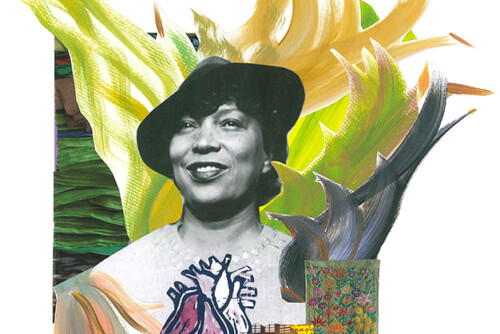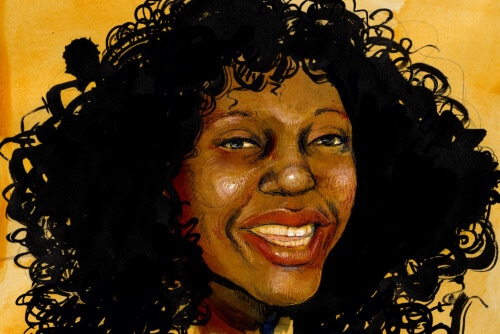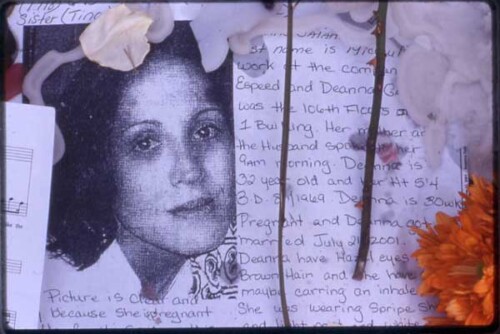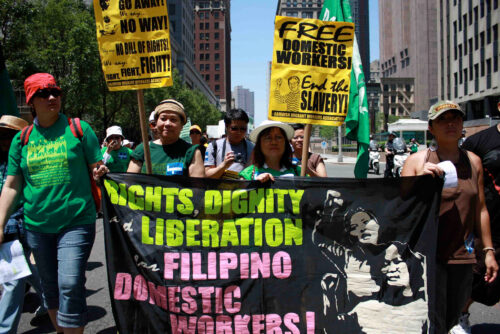The opening scene of Zora Neale Hurston’s Their Eyes Were Watching God (1937) depicts its protagonist, Janie Woods, returning to the all-Black town of Eatonville, Florida, at sundown and after the unfolding of the plot of the novel. According to the narrator of the free indirect discourse, the folk community sees Janie walk into town because dusk is the time for sitting on porches beside the road and talking. “These sitters,” the narrator says, “had been tongueless, earless, eyeless conveniences all day long. Mules and other brutes had occupied their skins. But now, the sun and the bossman were gone, so the skins felt powerful and human.”1 In this essay, I offer a brief close reading of Hurston’s use of a constellation of figurative language that tethers the Black folk community to the figures of various nonhuman animals as seen in the metaphor above. I contend that the semiotics of human and nonhuman animality broadly, and the metaphors, similes, and synecdoche that juxtapose the folk and animal figures specifically, should be treated not as objects of critical phobia but as essential features of the plot and the rhetorical structure of Their Eyes Were Watching God.
Largely a rereading or repurposing of extant readings of Hurston’s famous novel, this essay is a small addition to a chorus of groundbreaking work in Black studies that situates critiques of “Man,” “the human,” or liberal humanism alongside the modern, profoundly racialized and gendered discourse(s) of human and nonhuman animality.2 Among the most illuminating of these voices is Zakiyyah Iman Jackson’s, whose brilliant 2016 essay “Losing Manhood: Animality and Plasticity in the (Neo)Slave Narrative” is one of the most rigorous engagements in Black studies with the concept and figure of (non)human animality to date. Therein, Jackson posits that Toni Morrison’s Beloved (1987) explores, rather than rejects, racialized animal language and symbols in detail and with the goal of exposing “the complexity and contradictions that produce Blackness and animality as proxies, not through the refutation of bestial imagery but rather through its magnification and deconstruction.”3 While the reflections I draw out below suggest Hurston’s goals for her own use of racialized animal imagery and language are a bit more ambivalent, my analysis is deeply inflected by Jackson’s generous reading practice and the rigorous theoretical framework she proffers. What follows is indebted to the work of Jackson and other scholars who demonstrate that Black studies is equipped with the requisite interpretive protocols to objectify and disentangle the “dreaded comparison” in all its spectral guises.
The work of the sustained or extended metaphor with which I begin this essay is to compare the community of porch sitters to “conveniences” (behind which we might hear a trace of “commodities”) as well as “mules and other brutes.” Metaphor, of course, is a figure of speech that compares two things that are not the same by saying one is the other. It is a vehicle for establishing a symbolic comparison through abstraction. Notably, Janie is not – here, and hardly ever – made the subject of these comparisons to which the folk and other characters are regularly subjected. This unevenness effectively works to create a distance and difference between Janie and the folk community. Gesturing at this distance from a different vantage-point, Hazel Carby describes the novel’s opening scene as part of the first chapter’s function of framing “the antagonistic relation between Janie, as a woman alone, and the folk as community.”4 In an insightful essay, “The Politics of Fiction, Anthropology, and the Folk: Zora Neale Hurston,” Carby argues that Their Eyes Were Watching God displaces the very discourse of the folk for which it is so celebrated, as well as the contemporary crises of Hurston’s day (the first wave of the Great Migration), with a discourse of individualized autonomy, calibrated toward a pursuit of the pleasure of the self. Carby keenly points out that Hurston has Janie respond to the folk community’s judgment through synecdoche,5 calling it a “Mouth-Almighty” and referring to the sitters as “skins.”6 Carby’s reading is profoundly instructive in that it is unmoored from what she senses as a strictly celebratory approach to the novel on the part of her contemporaries. For her, the conflict between Janie and the folk community mirrors Hurston’s own troubled relationship to the same, despite Hurston’s attempts to gloss over this conflict and represent herself as the intellectual who, without question, could authentically define and represent “the folk.”
In an effort to further develop Carby’s reading, I ask, in structural and symbolic terms, why it is that Hurston needs Janie to be distinguished from the folk in order to, or as a crucial part of her, quest. Why does the start of the novel, which is also the end of that quest, require Janie’s isolation from the community or, as Hortense Spillers has it, her “movement toward an individualistic liberation”?7 One way to continue to think about the questions that Spillers and Carby raise concerning Janie’s trajectory is to hone in on the precise content and form of what is arguably Hurston’s most significant rhetorical strategy for representing this conflict between Janie and the folk community. I contend that Hurston relies on figurative language, namely metaphor, to stage comparisons between the folk community and nonhuman animals in order to represent what is for her the distance and difference between Janie and the folk. Put differently, if, as Henry Louis Gates, Jr, argues, the pear tree or the tree in bloom is “Janie’s master-trope on her road to becoming,”8 then the muddled metaphor that associatively links the folk community and the figure of the nonhuman animal-other is a crucial tool by which Hurston attempts to seamlessly secure Janie a position as a questing subject in and on the precarious terms of a liberal humanist imagination. I believe we can observe as much, without making a judgement against Hurston, and that we stand to benefit from reading this move symptomatically, teasing out just how integral it is to the universe of the novel, if not our own imaginations.
Again, the narration reads, “These sitters, had been tongueless, earless, eyeless conveniences all day long. Mules and other brutes had occupied their skins. But now, the sun and the bossman were gone, so the skins felt powerful and human” (1–2). There is a common-sense designation of value to “human” over and against “animal” upon which the metaphor and synecdoche are based. At the same time, the “so” in the final sentence of the quotation is a conjunction that implies causality between the presence of “the sun and the bossman” and the “skins” not having had access to the feeling of being “powerful and human.” As a phrase, “the sun and the bossman” takes on a metonymic function,9 signifying the logics inherent to New World chattel slavery and the liberal humanist project built upon it. In other words, the sun and the bossman index who can feel (and that it is a feeling matters) “human,” and this acknowledgment deuniversalizes or demystifies “humanity” and exposes it as an (anti-Black, anti-slave) construction. I find it vital to hold, at the very least, these two starkly different if not opposite readings of the figurative language together, rather than jettisoning one or the other in order to condemn or celebrate the author. It strikes me as crucial to read Hurston’s metaphors as metaphors, which is to say as comparisons made through abstraction such that they cannot always or readily be pinned down to a single, straightforward interpretation.
There are dozens of references to nonhuman animals, literal and figurative, in Their Eyes Were Watching God. In addition to metaphor, many take the form of the simile.10 For example, when Janie objects to being married off to Logan Killicks by her grandmother, she points out that “his toe-nails look lak mule foots” as one of the reasons she has no desire to be with him (28). After the death of her second husband, Jody Starks, Janie gets an urge to slap her new male suitors who sit around “grinning at her like a pack of chessy cats, trying to make out that they looked like love” (108). Later, Tea Cake ironically says that he has been “workin’ lak uh dawg” for two weeks in order to earn money to take Janie to the town picnic (129). When he disappears with her two hundred dollars and Janie begins to worry about whether or not he’s deserted her, the narrator tells the reader, “don’t care how firm your determination is, you can’t keep turning round in one place like a horse grinding sugar cane” (139). This is one of the rare moments where the explicit function of the figurative language is to emphasize how a character is distinct from, rather than similar to, an animal figure, and this dubious honor is reserved for Janie.
Familiar readers will recall the dramatic scene of Janie’s public embarrassment of Joe by signifying on his sexual impotence in the store at the close of chapter 7. In the final sentence of that chapter, Joe violently slaps her and drives her from the store. To start chapter 8, the narrator assures us that Joe “didn’t really hate Janie, but he wanted her to think so. He had crawled off to lick his wounds” (96). It is hardly a coincidence that Joe is metaphorically rendered animal in such pronounced terms immediately after he commits this irreversible violence against Janie and their partnership. The metaphor picks back up with a slight change just a few paragraphs later as Janie notices the tremendous way in which Joe has aged and the narrator describes “a loose-filled bag of feathers [that] hung from [Joe’s] ears and rested on his neck beneath his chin.” After speaking to the doctor from Orlando, Janie knows her estranged husband’s death is imminent and, in a gesture of repairing the irreparable, goes to talk to him on what will soon be his deathbed. As Janie walks in the room to see Joe, the narration describes that something “stood like an oxen’s foot on her tongue” (100) and she receives a “ferocious” look from him. The narrator further describes that Joe “gave a deep-growling sound like a hog dying down in the swamp and trying to drive off disturbance” (101), an ironic return on his earlier statement that Janie “ain’t got no mo’ business wid uh plow than uh hog is got wid uh holiday!” (34). After unsuccessfully trying to get Janie to leave the room, Joe “gave another ground grumble and eased over on his back” (101). Janie mentions that she would like to say some things before it’s too late. Quickly spotting the surprise on Joe’s face, she confirms his worst fear; despite what “dat multiplied cockroach” (102), the two-headed or hoodoo doctor, has told him, his death is imminent. The narrator describes a deep sob coming from his weak frame, “like beating a bass drum in a hen-house.” Though Joe does not literally become a hog, Hurston figuratively marks the scene of his death with metaphor and simile driven by the figures of nonhuman animals.
Later in the novel, amid the turmoil of the storm, Janie gets swept into deep water and is in danger of drowning. A cow swims by with a large dog sitting on its shoulders, and Tea Cake yells for Janie to grab its tail. As the attacking (mad) dog charges down the back of the cow toward Janie, the narrator describes Tea Cake “split[ting] the water like an otter” (194), ultimately killing the dog, but not before it bites him just under the eye. Crucially, this is not a metaphorical cow or dog; they are material life forms entangled with one another and the characters, and they indelibly mark the story through this encounter. Roughly a month later, Tea Cake begins to show the telltale sign of rabies, and as his symptoms grow more virulent the narration lingers on his animal-otherness. “Tea Cake was gone,” the narrator says, “Something else was looking out of his face … He almost snarled when he saw her dressed to go … And she was beginning to feel fear of this strange thing in Tea Cake’s body” (213). As Janie attempts to leave and fetch the doctor in desperation, the narrator describes how “[Tea Cake] gave her a look full of blank ferocity and gurgled in his throat.” The narrator darkly alludes to folks who would “treat Tea Cake like he was some mad dog” if they were to see him in this state (214), and shortly thereafter, he grabs the pistol that Janie has wisely rotated so as to snap three times before firing. Tellingly, Hurston returns to the adjective “ferocious,” having used it for the scene of Joe’s death, to describe the look in Tea Cake’s eye as he pulls the trigger (216). Just before he pulls the trigger a fourth time, Janie shoots him dead in self-defense.
Like the folk community, for which they function as proxies, there is a little animal-other in each of Janie’s partners. But the constellation of representations warrant a more complicated response from us as readers than simply calling this “dehumanization,” which actually tells us very little. To go further into Hurston’s consistent depiction of that which is “animal within the human” or “black(ened) humanity,”11 to borrow Jackson’s formulation, makes clear that these representations function to erect what is for Hurston an irreconcilable distance between Janie and the folk. If the novel’s plot suggests that Tea Cake and Joe Starks had to die for their respective actions (performance), its rhetorical structure implies that they had to be culled from Janie’s world because of some animal-essence or their being the “animal within the human” (ontology); one they share with the folk and with Nanny, Janie’s grandmother. Crucially, it is not just her romantic partners who embody this animal-other within for Janie, although a more detailed reading of what happens at the intersections of animality and patriarchal violence is certainly worth exploration. Indeed, Spillers goes so far as to read a “moral ferociousness that verges on misogyny” in Hurston’s representation of Nanny (as well the folk), who is the paradigmatic embodiment, as symbolic Black mother, of this Black(ened) humanity or “the animal within the human” folk community.12 One of the most telling moments of the novel occurs as Janie reflects on the grand scheme of her life and her relationship with her grandmother after Joe’s death:
Digging around inside of herself like that she found that she had no interest in that seldom seen mother at all. She hated her grandmother and had hidden it from herself all these years under a cloak of pity. She had been getting ready for her great journey to the horizons in search of people; it was important to all the world that she should find them and they find her. But she had been whipped like a cur dog, and run off down a back road after things … Some people could look at a mud-puddle and see an ocean with ships. But Nanny belonged to that other kind that loved to deal in scraps … She hated the old woman who had twisted her so in the name of love. (107)
Recalling the book’s opening invocation of “tongueless, earless, eyeless conveniences,” the narration, imbued with Janie’s subjectivity in the manner typical of free indirect discourse, suggests Nanny’s investment is in “things” rather than “people.” However, Tea Cake’s transformation from person to “something else” blurs the distinction that Janie wants to insist on and use to define herself against Nanny. Janie’s performative rejection of Nanny at one of the novel’s key crossroads suggests that Hurston very much wants the reader to see Nanny’s attempt to pull Janie into proximity with nonhuman animality as unsuccessful. By symbolically rejecting Nanny, Janie can be something other than a mule and can escape the animalization that marks the other characters, but as a result (as Carby and Spillers each note) of individual exceptionalism and experience rather than any kind of collective endeavor with or on behalf of the community to thwart or revalue the signs and symbols of Black abjection.
A final indispensable scene across which to follow the animal-other occurs much earlier in the text, just after Nanny catches a young Janie kissing Johnny Taylor and decides that she must be soon married away. Janie scoffs at the idea of marrying Logan Killicks, and a frustrated and fearful Nanny responds by violently slapping her. Afterwards, Nanny shifts her demeanor and holds the girl in an intimate moment worth quoting at length:
Honey de white man is de ruler of everything so fur as Ah been able tuh find out. Maybe its some place way off in de ocean where de black man is in power, but we don’t know nothin’ but what we see. So de white man throw down de load and tell de nigger man tuh pick it up. He pick it up because he have to, but he don’t tote it. He hand it to his womenfolks. De nigger woman is de mule uh de world so fur as Ah can see. Ah been prayin’ fuh it tuh be different wid you. (17)
As with the porch sitters in the novel’s opening scene, the Black woman, here, is not “like” the mule of the world. Hurston mobilizes a metaphor that juxtaposes Black women’s status as beasts of burden in the afterlives of slavery with that of a mule, an equation that underscores and resonates with the Spillersian notion of (un)gendered Black female flesh. Nanny makes clear that the “nigger woman” is the mule of the world, as is indicated by her experience. By contrast, the “nigger man,” in this metaphor, is not immediately delivered to the status of mule, at least to the extent that he will participate in the hermetic sealing off of the Black woman from “de world.” We get ample evidence of this across the text from Joe’s attempt to “class [Janie] off” (132) or prevent her from making a public speech, to Tea Cake’s physical abuse of her, to the cavalier manner in which he takes her two hundred dollars without telling her in order to go gambling. The symbolic rejection of Nanny, who, for Hurston as much as for Janie it seems, represents an embodied, archaic testimony to the Black woman’s nonhuman status, is the condition of possibility of Janie’s road to becoming truly opening up. “Ah didn’t want to be used for a work-ox and a brood-sow” (19), Nanny says to Janie in a metaphor grounded so emphatically in the history of Black chattel slavery that it does not feel figurative. In Nanny’s presence, the figurative proximity between Blackness and nonhuman animality that Hurston is comfortable with so long as it can be attached to anyone but Janie comes under no small amount of pressure from the physical, psychic, and ontological violence of chattel slavery.
In conclusion, Their Eyes Were Watching God provides a generative locus from which to theorize the animalization of Blackness on which the modern world instituted itself without reifying “the human” or reproducing the denigration of the multiplicity of life brought together under the sign “animal.” Hurston’s use of figurative language, and metaphor in particular, ultimately reflects a murky ambivalence on her part. Carby and Spillers were right to diagnose the grating individualism that is so essential to the novel. Its plot and rhetorical structure, as I have illustrated, pivot on the production of distance and difference between Janie and the faceless Black mass of the folk community. At the same time, the novel is a raucous celebration of Black social life, a poetic testament to the gritty unevenness of sensory experience, of touch, taste, smell, dance, love, madness, and death. Moreover, it seems important to remember that this foray into and attempt to extract raw material (for one’s novel) from the spectral, convoluted, double-sided and shifting semiotics of racialized human- and nonhuman animality was very much in vogue during the Harlem Renaissance. Indeed, whether one embraced or rejected this approach, the white demand for representation of Blackness as a thing to be possessed – a primitive thing, a sensual thing, some thing atavistic – very much set the scene for what we think of as a Black literary movement. Where Carby and Spillers would read Hurston’s desire to distinguish Janie from the folk as something wrong with or intrinsic to Hurston’s particular investments as an individual, I have pushed that reading a bit further. Perhaps, ultimately, we, as black critics and black people, all have a streak of Janie Woods via Hurston in us, which is to say a desire to put a safe amount of difference and distance between ourselves and the Black folk community, discursively fixed as abject. Of course, just because she tried to make Janie a questing subject on the terms of liberal humanism does not mean that Hurston succeeded. We should remember that the skins merely felt powerful and human when the sun and the bossman left. If, in the end, Hurston seems to fear, hate, and be repulsed by even as she is so clearly drawn toward and finds beauty in the animal-other within, the Black(ened) human given to her animality, then at least one of her enduring gifts to us is the opportunity to relate to our own animality, which is irreducible to but never separate from our Blackness, differently.
- Zora Neale Hurston, Their Eyes Were Watching God (Philadelphia: J.B. Lippincott, 1937; New York: HarperCollins Publishers, 2000), 1–2. Citations refer to the HarperCollins edition and subsequently appear in the text. [↩]
- See Che Gossett, “Blackness, Animality, and the Unsovereign,” Verso Books Blog, 8 September 2015, https://www.versobooks.com/blogs/2228-che-gossett-blackness-animality-and-the-unsovereign; Joshua Bennett, “Being Property Once Myself: In Pursuit of the Animal in 20th Century African American Literature,” PhD dissertation, University of Pennsylvania, 2016; Zakiyyah Iman Jackson, “Losing Manhood: Animality and Plasticity in the (Neo)Slave Narrative,” Qui Parle 25, no. 1–2 (2016): 95–136; and Bénédicte Boisseron, Afrodog: Blackness and the Animal Question (New York: Columbia University Press, 2018). [↩]
- Jackson, “Losing Manhood,” 108. [↩]
- Hazel Carby, “The Politics of Fiction, Anthropology, and the Folk: Zora Neale Hurston,” in New Essays on Their Eyes Were Watching God (Cambridge: Cambridge University Press, 1990), 82. [↩]
- A figure of speech wherein a part is referred to as the whole. [↩]
- Ibid., 83. [↩]
- Hortense Spillers, “A Hateful Passion, A Lost Love: Three Women’s Fiction,” in Black, White, and in Color (Chicago: University of Chicago Press, 2003), 104. [↩]
- Henry Louis Gates, Jr, The Signifying Monkey: A Theory of African American Literary Criticism (1988; repr., Oxford: Oxford University Press, 2014), 171. [↩]
- A figure of speech in which a word or expression stands in for something closely related. [↩]
- A figure of speech making a comparison using “like” or “as.” [↩]
- Jackson, “Losing Manhood,” 97. [↩]
- Spillers, “A Hateful Passion,” 107. [↩]




